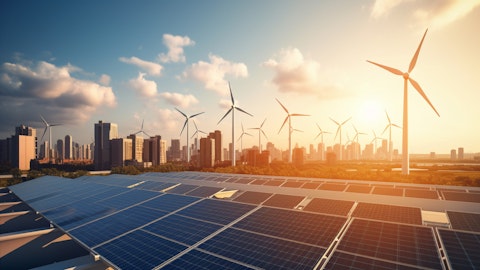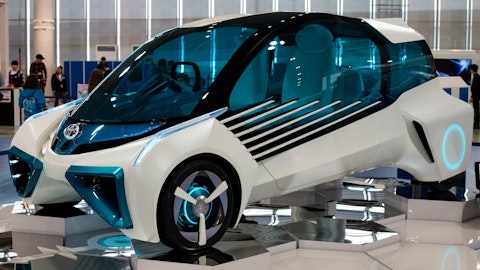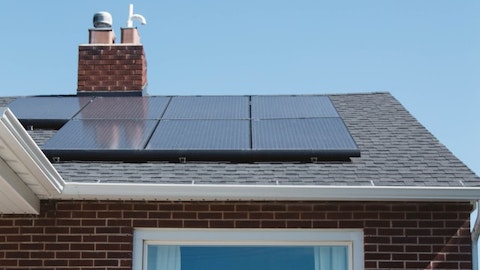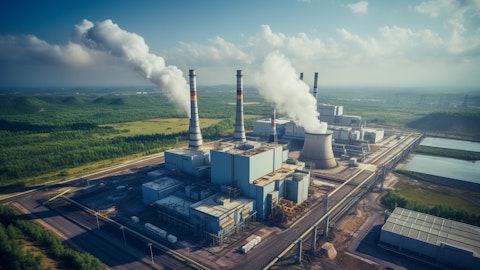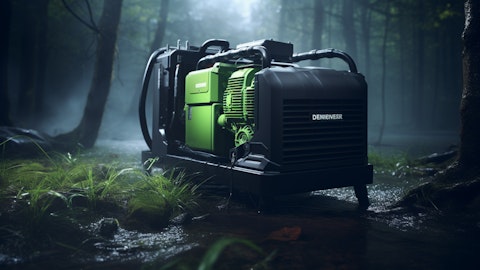Pavel Molchanov: Thanks for taking the question. I guess it was about a year ago, you entered the European market for the first time, and it is Europe where some of the green hydrogen projects are moving forward. So, I know you’ve sold some fuel cells in the UK and elsewhere. Are you making any progress with the electrolyzer product in Europe?
KR Sridhar: So, we are in pre-FEED studies with a few potential customers in Europe as we speak. But let’s dial in for a second on the green hydrogen story too, right? Andrew started off by talking about the power shortage and what we do. Power is electricity and it’s that electricity that makes the molecule. So, the fact that there’s a shortage of that electricity even when it’s being made is going to stress making a molecule with that electricity. That’s the macro that we need to understand, and then say, if you’re going to make that molecule with that precious electricity, obviously, the technology that uses less of that electricity is what’s going to win. So, we’re very confident in Europe to be able to get there. And we are talking to several customers right now.
But it seems to us that the pace of implementation is going to be slower than what all of us want. However, as Greg correctly alluded, and I want to underline that, for us, that’s an optionality and not being a pure play just on electrolyzers is an amazing competitive advantage for us, and I can’t overemphasize that.
Pavel Molchanov: Thank you very much.
Operator: Thank you. Our next question comes from the line of Ben Kallo of Baird. Please go ahead.
Ben Kallo: Hey. Thank you, guys. And, Greg, sorry to see you leave. Just thinking about this year, can we talk a little bit, KR, maybe about the Fremont factory ramps up? If we should see a margin impact in different times because of the ramp up? And then there’s some confusion about the different servers that you sell. Could you update us on what servers you’re selling now and how that impacts sales? And I’ll follow-up.
Greg Cameron: Hey, Ben, it’s Greg. I’ll take the question on Fremont. So, at the end of last year, we had a major milestone in the company in that we exited our previous factory in Sunnyvale, and we’ve now consolidated all of our manufacturing capacity in Fremont there, all the tooling has moved over and we’ve kept it just shy of that 700 megawatts of capacity when you have all that tooling there. I think we can still at least double, if not more, based on the size commitments and our ability to drive more automation and density in that space. From a cost standpoint, there’s dollars that we’re going to save between rent and utilities and indirect labor being over the both operating factories, that’s going to have an improvement in our product cost year-over-year.
I would also say that we’re going to find — by running two factories within driving distance of each other, we’re going to find some hidden factories in that process that’s going to continue to take cost out. We set a target for the team of at least double digits, 10% down, but they know very well that their target is higher internally than the one I’m going to give externally, and I think that they’ve got ample room to continue to drive not only material cost down, but increased automation and to make sure that they are contributing to our margin improvement this year as they did last year. They overachieved by 100 basis points. We got 13% versus our target of 12%. So, full confidence that they’ll overachieve again.
Operator: Thank you. Our next question comes from the line of Colin Rusch of Oppenheimer. Please go ahead.
Colin Rusch: Thanks so much. You gave us some color a little bit on some of the customers and the backlog for the year. But could you talk a little bit about the sales cycle and whether that’s accelerating or decelerating at all with some of these bigger projects? And with the mix and the incremental backlog moving pretty aggressively into the service revenue, just understanding what the dynamic is there?
Greg Cameron: Sure. Let me start with the service, because mathematically, remember that each year in our backlog, we absorb into revenue out of the backlog, only one year of the service. And then you add to that all of the additional service revenue on the deals that you booked. And then, when you’ve got something like Korea that is a 20-year high-performance commitment, the service payments there are high, and that’s what drove the differences on the volumes between if you looked at mid-single digits on product and over 20% on service, and that’s how that mathematically ticks together. As I think on the sales cycle, I’ll start with it. I’m very encouraged with Aman coming in. I made it in my prepared comments. What I like about Aman coming in is a couple of things.
One is he’s sold in this space before. And although we didn’t overlap directly, I was a GE Capital guy, he was an industrial guy, but we both have the same training with corporate audit staff and other places and bring an incredible hopeful mind — bring that GE mindset around process. But as well as he knows the space very well. So, I think the combination of process as well as his commercial acumen is going to continue to make sure that we’re accelerating some of these larger transactions in, because there’s an overlap on how he saw the world before and how we see the world, and I think it’s a really good fit.
KR Sridhar: Colin, I would add to that the following things, right. Number one, like I said, these are much bigger projects, which means you would expect a slightly more elongated cycle. There are more greenfield projects and not brownfield projects, you would expect an elongated cycle. Having said that, the macro of lack of power is going to make people take decisions faster because they don’t have a choice. There’s a forcing function not coming from us on the selling side, but from the customer needing that solution. We are a solution that the customer needs. Now, Aman coming and joining us like Greg correctly pointed out, have sold 5 gigawatts worth of power globally in the last two years. So, he knows a thing or two about taking complex deals and shrinking the cycle. That’s what we expect him to do out here.
Operator: Thank you. Our next question comes from the line of Michael Blum of Wells Fargo. Please go ahead.
Michael Blum: Thanks. Greg, thanks for all your help through the years, and wish you the best of luck. I wanted to — in your prepared remarks, you reiterated the long-term targets, driven mostly by the power — the core power generation business. You’ve kind of addressed the electrolyzers to some degree, but you seemed at least to me a little less optimistic on the marine segment. So, just want to get a sense of maybe for both of those, but specifically the marine, any progress and what’s your kind of latest outlook there?
Greg Cameron: Yeah, I’ll start, because I’ll just address it and then KR has been really close to that market as of late. So, listen, for me, as we built out our long-range targets over the decade, we always planned on marine really beginning to contribute in the back half of the decade. And I’d say that as we continue to look at our overall framework, we see that timing is probably still about where I’d expect it to be. So, as I think about contributors to 2024, 2025 for the business, it’s really focused on delivering our power generation equipment with all its enhancements, and I think that is a wise way in which we built our long-term framework was that we were building it based off the market we saw. And then, as other markets evolved, it would enhance and increase our growth rates.
So that — so everything is still there. It’s still about where I thought it would be, and our full expectation that it will be an enhancement to our power generation business as we move out later in this decade. KR, you’ve been close to this market.
KR Sridhar: Sure. So, let me take marine and expand that to shipping as a — like as a whole, okay? So, the reason to do that is when we talked to you first, we talked about cargo ships, now — like container ships. The opportunity with cruise ships and yachts is very interesting and we have several customers extremely interested in this. You heard about our MSC Europa and we are working with the likes of Royal Caribbean on this. And so, what we are doing is we are forming a consortium of these people, the key players in this field, to give us a common set of requirements, so we can develop a product that spans across the entire industry. That’s one. But the second part where they are seeing their pain points is when they get to port, having enough power at the port.
And this is our bread and butter business that we need to be able to customize using our Be Flexible platform to be able to provide port power. So, this is again something we are working on. So, like Greg said, expect this to be the ’26-plus revenue, but we think this is a very important area for us and we are continuing to work.
Operator: Thank you. Our next question comes from the line of Julien Dumoulin-Smith of Bank of America. Please go ahead.
Cameron Lochridge: Hey, team. This is actually Cameron Lochridge on from BofA on Julien’s team. I just wanted to come back and real quick ask about the backlog and just the composition there. If you can give a little bit more color around bifurcating between SK and what else is included there? Specifically, if there are any — if there’s any orders related to data centers or hydrogen? Just kind of if you could give a little more color on the composition of the backlog right now?
Greg Cameron: Yeah. Cameron, it’s Greg. So, listen, on our backlog, I would tell you it still is — the vast majority of it is around our natural gas fuel cell leases they start. Our customer obviously has optionality to move that to a hydrogen fuel cell in the future, but the primary product at which we’re selling there is — today they’re — as we move forward, I would expect that backlog to expand to electrolyzers and other things, and that’s why we’ve killed the megawatt metric and just focused on dollars, because that’s most important. As you think about Korea, we talked about that in the call for both product and service and that’s out there. And as you do the variances year-over-year, you can see that we’ve incorporated the entire Korea opportunity that we have with ecoplant in that backlog.
So, it’s pretty healthy at the size given the overall volume of it at $12 billion on a — company is short — just shy of $2 billion, and we’re really excited about to continue to grow that and provide the revenue for the business going forward.
Operator: Thank you. Our next question comes from the line of Chris Dendrinos of RBC Capital Markets. Please go ahead.
Chris Dendrinos: Yeah, thank you. You all talked quite a bit about the large opportunities, the data centers, the Korea. Well, I wanted to hone in a bit more on the singles, the doubles or the bunts of the company. And what’s the demand environment for that right now? How much is it being impacted by interest rates? And maybe just overall kind of perception of that market, how are things kind of looking right now? Thanks.
Greg Cameron: Yeah, let me start with the interest rates, and we talked about this 90 days ago on the last call. When you think about other companies that are in the space, right, and the impact of interest rates on their pricing as well as their competitiveness to the customer, the one thing that’s different about the Bloom solution is if you break it down into how much is CapEx versus fuel versus service, roughly say it’s a third, a third, a third. That’s not perfect, but think about it that way. So, the interest rates are a higher basis — a benchmark rate that the deal is going to be priced on. It’s really going to be only impactful on the CapEx portion, while the fuel would not and service would not. So, as a rule, we are probably impacted call it a third or 40% of what other companies are in the space, you think wind, think solar.
So that’s different from us. The other thing that’s been happening as we’ve gone through our PPA financing is just frankly the Bloom credit quality has gotten better as we strengthen the balance sheet here. So, the component around the Bloom-specific credit has gone down. So, while maybe over the last 12 months, we’ve seen some slight increase in the benchmark rates up in the IRRs that come out of our PPA, but for the most part, we’ve been able to offset that through the cycle by just our improving and finding more and more competitive bidding around the customers.
Operator: Thank you. Our next question comes from the line of Jordan Levy of Truist Securities. Please go ahead.
Jordan Levy: Thanks all for all the comments, and Greg, thank you for everything. I want to echo everyone else’s sentiment. Not — I don’t want to belabor anything on ASPs, but I did notice a tick down in 4Q. I know that can bounce around from quarter to quarter. So, maybe if I can just get some color on that?
Greg Cameron: Yeah, mostly — it’s simple, mostly mix. If you think about it, third quarter versus fourth quarter, we had the repowering in the third quarter as you move into the fourth quarter to there. And remember, we just take the ASP. I don’t separate it out for mix around micro grids versus grid parallel or other things. So, it’s more than outpaced our cost down, which is really where you want to see the difference on those numbers. They’ve got a 10-point expansion last year on ASP versus cost down.
KR Sridhar: And just based on where utility costs are going and given the shortage of power, we don’t see a pricing pressure as we look forward.
Operator: Thank you. Our next question comes from the line of Noel Parks of Tuohy Brothers. Please go ahead.
